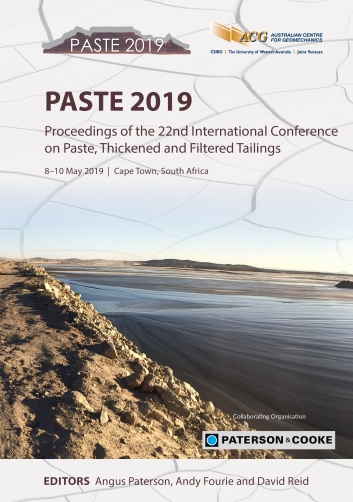Use of reactive MgO-activated slag in high sulphide-bearing lead-zinc cemented backfill

|
Authors: Guo, LJ; LI, WC; Pan, A; Liu, GS; Xu, WY |
DOI https://doi.org/10.36487/ACG_rep/1910_31_Guo
Cite As:
Guo, LJ, LI, WC, Pan, A, Liu, GS & Xu, WY 2019, 'Use of reactive MgO-activated slag in high sulphide-bearing lead-zinc cemented backfill', in AJC Paterson, AB Fourie & D Reid (eds), Paste 2019: Proceedings of the 22nd International Conference on Paste, Thickened and Filtered Tailings, Australian Centre for Geomechanics, Perth, pp. 425-436, https://doi.org/10.36487/ACG_rep/1910_31_Guo
Abstract:
The long-term strength of cemented backfill mass with ordinary Portland cement binder generally decreases with sulphide content due to the formation of expansive phases such as gypsum. This paper investigates the potential of using commercial reactive MgO-activated ground granulated blast furnace slag (MgO-GGBS) in cemented backfill from high sulphide content lead-zinc mine tailings to prevent long-term strength loss. The study focuses on the effect of MgO-GGBS content and the reactive MgO dosage on the unconfined compressive strength (UCS) and the shrinkage/expansion rate. The test results showed that the 28-day UCS of cemented backfill achieved the target strength (≧1.0 MPa) with 14 wt% MgO-GGBS content, and the reactive MgO dosage affected the long-term UCS and the shrinkage/expansion rate of cemented backfill body. The main hydration products when using MgO-GGBS were hydrated calcium/magnesium silicate (C-S-H/M-S-H) and hydrotalcite-like phases (Ht). Cemented backfill has a porous opening microstructure. Micro-expansion produced by appropriate MgO content can increase microstructure density, which increases short- and longterm UCS of cemented backfill body, while sustained expansion produced by excessive MgO could destroy the MgO-GGBS microstructure, decreasing the UCS of cemented backfill. We conclude that the mechanical and extension properties of cemented backfill body are highly dependent on the reactive MgO content of the MgO-GGBS. The optimum value of responsive MgO content of MgO-GGBS was 2.5–7.5 wt% to achieve the long-term stability of cemented backfill.
Keywords: cemented backfill, slag binder, unconfined compressive strength, shrinkage rate, microstructure
References:
Amaral, LF, Oliveira, IR, Saloma, R, Frollini, E & Pandolfelli, VC 2010, ‘Temperature and common-ion effect on magnesium oxide (MgO) hydration’, Ceramics International, vol. 36, pp. 1047–1054.
Bao, W & Huyuan, Z 2007, ‘Long-term deterioration of cemented paste backfill due to sulphide oxidation’, Industrial Minerals and Processing, vol. 10, pp. 29–31 (in Chinese).
Ben Haha, M, Lothenbach, B, Le Saout, G & Winnefeld, F 2011, ‘Influence of slag chemistry on the hydration of alkali-activated blastfurnace slag – part 1: effect of MgO’, Cement and Concrete Research, vol. 41, pp. 955–963.
Benzaazoua, M, Belem, T & Bussiere, B 2002, ‘Chemical factors that influence the performance of mine sulphidic paste backfill’, Cement and Concrete Research, vol. 32, pp. 1133–1144.
Benzaazoua, M, Ouellet, J, Servant, S, Newman, P & Verburg, R 1999, ‘Cementitious backfill with high sulphur content: physical, chemical, and mineralogical characterization’, Cement and Concrete Research, vol. 29, no. 5, pp. 719–725.
Ercikdi, B, Clanger, F & Kesimal, A 2010, ‘Utilization of water-reducing admixtures in cemented paste backfill of sulphide-rich mill tailings’, Journal of Hazardous Materials, vol. 179, pp. 940–946.
Ercikdi, B, Kesimal, A & Cihangir, F 2009, ‘Utilization of industrial waste products as a pozzolanic material in cemented paste backfill of high sulphide mill tailings’, Journal of Hazardous Materials, vol. 168, issues 2–3, pp. 848–856.
GB 1999, GB/T 17671-1999 Method of Testing Cements-determination of Strength, Standardization Administration of China, .
ISO 2005, ISO 15901-1:2005 Pore Size Distribution and Porosity of Solid Materials by Mercury Porosimetry and Gas Adsorption – Part 1: Mercury Porosimetry, International Organization for Standardization,
Jiaguo, H & Desheng, G 2003, ‘A research on cemented filling of tailings at Tongshan Copper Mine’, Non-ferrous Metals, vol. 55, issue 4, pp. 127–130.
Jin, F, Gu, K & Al-Tabbaa, A 2014, ‘Strength and drying shrinkage of reactive MgO modified alkali-activated slag paste’, Construction and Building Materials, vol. 51, pp. 395–404.
Jin, F, Gu, K & Al-Tabbaa, A 2015, ‘Strength and hydration properties of reactive MgO-activated ground granulated blast-furnace slag paste’, Cement & Concrete Composites, vol. 57, pp. 8–16.
Kesimal, A, Yilmaz, E & Ercikdi, B 2004, ‘Evaluation of paste backfill mixtures consisting of sulphide-rich mill tailings and varying cement contents’, Cement and Concrete Research, vol. 34, pp. 1817–1822.
Li, C, Sun, H & Li, L 2010, ‘A review: the comparison between alkali-activated slag (Si+Ca) and metakaolin (Si+Al) cements’, Cement and Concrete Research, vol. 40, pp. 1341–1349.
Qinhua, L, Huili, L & Yanping, B 2017, ‘An analysis on forms and potential migration capacity of heavy metals in tailings, Huanjiang, Guangxi province’, Industrial Safety and Environmental Protection, vol. 43, issue 1, pp. 33–35.
Shiyang, T 2015, ‘A review on heavy metal pollution in basins near the Dabao Mountain mining area’, Journal of the Graduates Sun Yat-Sen University, vol. 36, issue 1, pp. 1–7.
Ying, C, Binghui, C & Qi, Z 2018, ‘Distribution of heavy metals in water-surface sediments in AMD, Dabao Mountain in North Guangdong province and influential factors’, Journal of Environmental Sciences, vol. 38, issue 1, pp. 134–141.
Zheng, J, Guo, L, Sun, X, Li, W & Jia, Q 2018, ‘Study on the strength development of cemented backfill body from lead-zinc mine tailings with sulphide’, Advances in Materials Science and Engineering, vol. 2018, pp. 1–8.
Zheng, J, Guo, L & Zhao, Z 2017, ‘Effect of calcined hard kaolin dosage on the strength development of CPB of fine tailings with sulphide’, Advances in Materials Science and Engineering, vol. 2017, pp. 1–7.
Zheng, J, Zhu, Y & Zhao, Z 2016, ‘Utilization of limestone powder and water-reducing admixture in cemented paste backfill of coarse copper mine tailings’, Construction and Building Materials, vol. 124, pp. 31–36.
© Copyright 2025, Australian Centre for Geomechanics (ACG), The University of Western Australia. All rights reserved.
View copyright/legal information
Please direct any queries or error reports to repository-acg@uwa.edu.au
View copyright/legal information
Please direct any queries or error reports to repository-acg@uwa.edu.au


